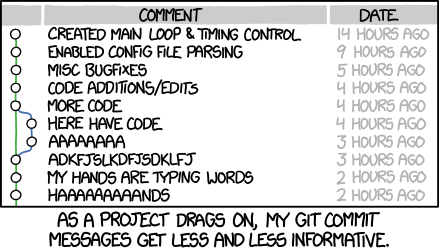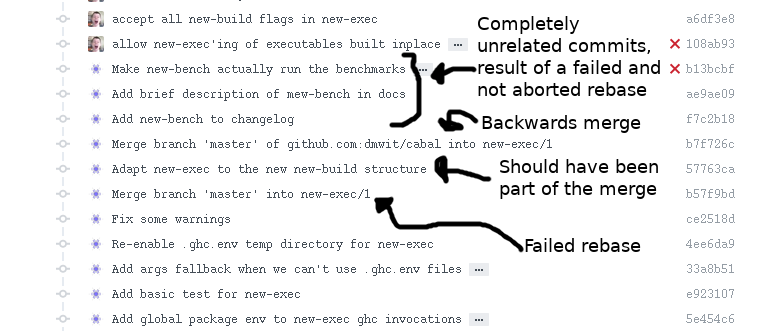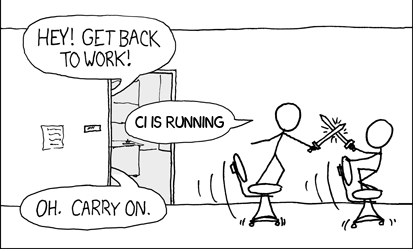Haskell Summer of Code 2017: Last Mile for `cabal new-build`: first and last status update
Reading time: 10 minutesTable of contents
Time flies! The Haskell Summer of Code is over, and this is my first and last status update. Last in the HSoC, but not in the project, as you'll see.
My goal was to bring cabal-install's new-build to a usable state, to eventually replace
the old commands.
¶ What has been done
My original proposal was way too optimistic. Of the many secondary and optional goals I planned, I've reached zero of them.
Fortunately they were, as I wrote, secondary.
new-build was and is a work in progress, but now it's close to completion.
Here's a summary of what I did:
¶
#3638: new-run, new-test, new-bench, new-exec
The most important goal of the project was to reach feature parity with old-build.
new-runis now fully functionalnew-testandnew-benchwork, except from some rough edges (like the ability to pass arguments to tests)new-exechas always been kind of an hack and we discussed a lot about it. Environment files helped a lot, and you should check them out!
With these commands, new-build only lacks new-install.
¶ Data-files
Data-files are additional files to be included in a package distribution (be it a sdist, a debian package or the store itself). They are used when including the data in the executable itself (eg. with a literal string or even a picture using file-embed) is not feasible or not practical.
The path to the data-files is hardcoded at compile-time (the --datadir flag),
and by default it is set to the store (where the majority of packages will reside).
For this reason, when using an inplace-built package, datadir resolved to a
non-existing directory.
Fortunately, datadir can be overridden with an environment variable, which is
now properly set by new-run.
If your project includes data-files, now you can use new-run and it should work without problems.
¶
new-install ...almost
This is the biggest command, because it actually handles four cases:
- nonlocal exes (
cabal new-install pandoc; pandoc file.md) - nonlocal libs (
cabal new-install lens; ghci; import Control.Lens) - local exes (
cabal new-installin a project) - local libs (
cabal new-installin a project, but for libraries, partially solved by environment files )
The first one, which allows the installation of programs from hackage,
and is probably the most used one (eg. cabal new-install pandoc),
is almost complete (needs some cleanup but it works).
The difference with old-install is that executables will be installed
in the store and symlinked to ~/.cabal/bin or equivalent.
This raises the problem of garbage collection: deleting the symlink leaves
the executable and all of its dependencies in the store.
In the future, a cabal garbage-collect command will track the symlinks and automatically clean the store.
¶ How to try it
Cabal HEAD should always build and should be fairly stable. If you want to try the new features just run:
cabal get -s cabal-install
cd cabal-install*
and then build/install it with cabal install
or cabal sandbox init + cabal install
or cabal new-build.
¶ What remains to do
90% of the work was done, now there's the other 90%.
The HSoC is now complete, but new-build cannot replace the old interface yet:
a few essential features are missing, and --now that I'm more familiar with the
cabal codebase-- I plan to work on some of them even outside of the HSoC period.
1

¶
Finishing new-install
One point done, three to go.
There is a design concept, but there are a lot of details to figure out, for the libraries in particular.
¶
The aforementioned garbage-collect
The store can grow rapidly and reach several GB in size, so we need a way to clean it up without influencing any built or installed package.
Again, there is a design concept on the issue page.
¶ Flags for package maintainers
Before replacing old-build, we need to be sure that package maintainers have still a way to control the location of binaries and data-files.
¶ Difficulties I encountered
¶ Big codebase
> cloc cabal
[...]
Language files blank comment code
--------------------------------------------------------
Haskell 1273 24897 28127 120096
Cabal is big. Big project, big functions, big types, big everything.
My biggest Haskell project before HSoC was two orders of magnitude smaller, and this was my first impact with a real-world project developed by a team during an extended period of time.

Haskell's strong types helped me a lot here. When I was working on new-bench,
I just "followed the types", and everything clicked on the first try,
as the legends say.
¶ Lack of documentation
The cabal bus factor is somewhat low.
Some parts of the codebase are completely devoid of comments, and we lack an overview of the codebase, some document which describes how cabal works and where to find certain parts.
Few mysterious entities, known as cabal devs, are the precious holders of such arcane knowledge, and to learn from them one must prove himself worthy of it by sheer pinging-perseverance on #hackage
...fortunately they are always happy to give some pointers to newcomers :) .

Moreover, the documentation is improving. The undocumented parts are mostly old code, and there is an ongoing effort to cover that too.
And again, Haskell's types come to the rescue! The type always enhances and often replaces the documentation in a more expressive way.
¶ Git
I now see that my git practices weren't the best...

well, not at this level, but...
Credit: xkcd (CC BY-NC 2.5)
I had to learn git the right way.
Coding alone is different than doing it in a team. Until now I almost never had to deal with conflicts2, and I almost always worked only on master.
In the cabal repo, lots of features get merged very often (well, more often than in a single user repo anyway), so it's easy to get a conflict. The history has to be kept clean, so I finally had to learn how to rebase properly too.
This didn't always go well. In an attempt to rebase an old branch I accidentally created a convoluted merge graph, almost impossible to disentangle.

Oh well, we learn from our errors.
I also had to exercise my multitasking skills by working on different branches. While the tests for one branch were running, I could write the docs for another command. Or two. The tests take a long time.
Which takes us to...
¶ Continuous Integration
There's 4 hours worth of tests, from ghc 7.6 (cabal has a support window of five years) to 8.2. And there are the FTP and the AMP in the middle.

But this is a plus! Apart from the many sword fights, the tests helped me catch a lot of bugs before even committing them. Now I use ci for many of my personal projects too.
¶ Project planning and organization
I never had to do a fixed project on a strict schedule, and Daniel helped me a lot here. If it wasn't for him I'll probably be trying to fix mostly pointless bugs now. Planning time is not wasted time!
¶ Beware the paths!
One little thing: cabal now uses a slightly different path for built binaries.
My build command used the old one, and I wasted 1 hour or so trying to figure out why my debug statements weren't printing anything.
This happened ~~two~~ three times.
You only need to worry about this if you use both pre- and post-2.0 new-build
in the same project though. While pre-2.0 puts the executables in
dist-newstyle/build/package-id/build/exe/exe,
post-2.0 puts them in
~~dist-newstyle/build/os/compiler/package-id/build/exe/exe~~
edit: this may change again before new-build becomes the default,
so just look it up in the docs or in your dist* folder.
¶ Good things
¶ Now I use new-build for all my Haskell projects!
Obviously I eat my own dog food now. And I like it.
In the next weeks I'll write a post about it, specifically about how to integrate new-build and vim.
¶ HSoC itself
The Haskell Summer of Code has been a wonderful experience, and I recommend it to every student who is reading this!
It taught me so much, and I loved being able to work on an open source project as widely used as cabal (well, in the Haskell ecosystem at least :-P ).
¶ The Community
And last but absolutely not least, the #hackage community was always very helpful and friendly, offering constructive criticism and involving me in related projects.
¶ Acknowledgments
I'd like to thank the Haskell community, always friendly and striving for knowledge; the organizers and sponsors, which made possible this HSoC; and most of all the #hackage folks: Daniel, my mentor, who helped me a lot when I was lost in the code or when I needed to plan, Duncan "dcoutts", Herbert "hvr", Mikhail "refold", Edward "ezyang", alanz, merijn, phadej, cocreature, and any others who helped me along the way.
¶ Upcoming posts
-
My new-build dev setup
-
The structure of cabal (I hope)
-
Some more technical challenges I encountered
This deserves a pipes pun
I'm beginning to suspect that the Haskell Summer of Code is just an evil scheme to lure some poor students to become permanent contributors to the Haskell ecosystem ;)